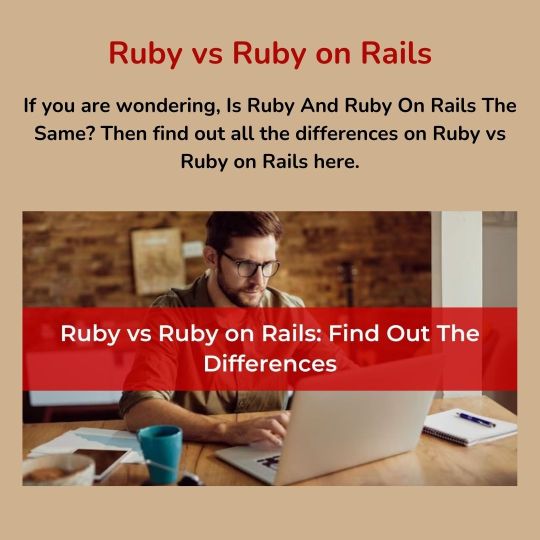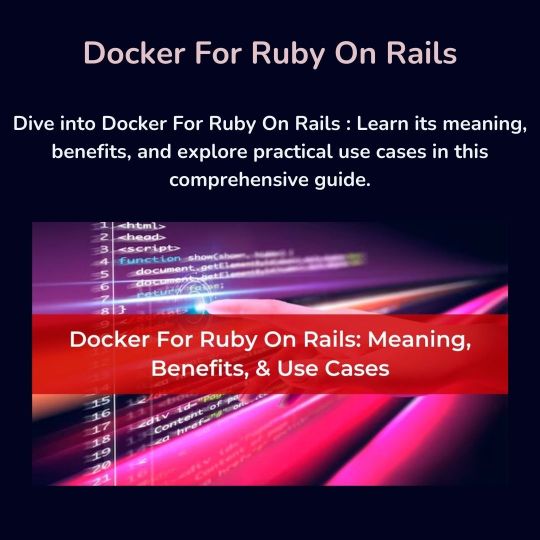#ruby on rails agency
Explore tagged Tumblr posts
Text
Ruby vs Ruby on Rails: Find Out The Differences - RORBits
If you're wondering whether Ruby and Ruby on Rails are the same, you're not alone. Many people are curious about the differences between the two. Ruby and Ruby on Rails, while related, serve distinct purposes. Discover all the key differences between Ruby and Ruby on Rails here.

#ruby on rails development#ruby on rails development company#ruby on rails company#ruby on rails development services#offshore ruby on rails development#ruby on rails development agency#ruby on rails development india#ruby on rails development firm#custom ruby on rails development services#ruby on rails development company usa#ruby on rails development company in india#ruby on rails development company india#hire ruby on rails development company#offshore ruby on rails development company#ruby on rails development new york#hire ruby on rails development companies#top ruby on rails development company#ruby on rails development companies in india#rails development companies#rails development company#ruby development company#rails company#rails development#ruby development#ruby on rails development companies#ruby on rails companies#ruby on rails web development#best ruby on rails companies#ruby on rails agency#ruby on rails consulting
0 notes
Text

Discover how Pattem's cutting-edge innovations, as a Ruby on Rails agency, may transform your business. Learn how our team of professionals leverages capabilities to create reliable, understandable web apps that propel commercial success.
0 notes
Text
Top Ruby on Rails Development Company | Protonshub Technologies
Hire top ruby on rails development company and get the best ROR solutions. Protonshub also provides ROR developers on contractual and full time basis that are capable of working on any challenges on the platform, and help your business to achieve complete potential. Connect: [email protected] to hire ROR developers.
#top ruby on rails development company#ror development company in usa#ror development company#ruby on rails development company in usa#ruby on rails web development company#ruby on rails development usa#ROR developers usa#ruby on rails application development services#ror development services usa#ruby on rails development company usa#ror development agency#ror development#ruby on rails development agency#ruby on rails development solutions usa#ror developers#hire ruby on rails developers
0 notes
Text
Top Ruby on Rails Development Company | Protonshub Technologies
As the top Ruby on rails development company, Protonshub has 11 years of experience in RoR web and mobile development. Also they use agile methodology to make your product journey easy. To get cost effective ROR solutions connect: [email protected]
#top ruby on rails development company#ruby on rails web development company#ruby on rails development company in usa#ror development company in usa#ror development company#ruby on rails development usa#ROR developers usa#ruby on rails application development services#ror development solutions usa#ror development service solutions usa#ruby on rails development solutions usa#ruby on rails development company usa#ruby on rails development agency usa#ruby on rails development agency#ror development company california#ruby on rails development service solutions
0 notes
Text
#lead generation companies in ahmedabad#lead generation companies india#Lead Generation Agency in India#Inbound Lead Generation Services#Outbound Lead Generation Services#Online Lead Generation Services#B2B Lead Generation Services#hire dedicated ruby on rails developer#lead generation#lead generation services#lead generation company#lead generation services in India
0 notes
Text
Difference between Web Design and Development: Build Your Site with Buzzz Booster
Web design and development are two closely related but distinct disciplines that involve creating and maintaining websites.

Web Design:
Web design focuses on the aesthetic and user experience aspects of a website. It involves creating the layout, visual elements, typography, and overall look and feel of the site.
Web designers use tools like Adobe Photoshop, Sketch, or Adobe XD to create mock-ups and prototypes of websites. They also consider factors such as user interface (UI) design, colour schemes, branding, and accessibility.
Key skills for web designers include graphic design, typography, colour theory, and understanding of user experience (UX) principles.

Web Development:
Web development refers to the process of building and maintaining the functionality of a website. It involves writing code that powers the website and makes it interactive and dynamic.
Web developers use languages like HTML, CSS, and JavaScript for front-end development (what users see and interact with in their browsers) and languages like PHP, Python, Ruby, or Node.js for back-end development (server-side scripting and database management).
Web developers may also work with frameworks and libraries like React.js, AngularJS, or Vue.js for front-end development and frameworks like Django, Ruby on Rails, or Express.js for back-end development.
Key skills for web developers include proficiency in programming languages, understanding of web architecture, databases, APIs, and knowledge of web security best practices.

Buzzz Booster is a trusted web design and development agency dedicated to building innovative and user-friendly websites. With a focus on both design and functionality, Buzzz Booster combines creative expertise with technical proficiency to deliver outstanding web solutions. Their commitment to crafting engaging user experiences and implementing cutting-edge technologies sets them apart in the industry. Whether it's designing captivating visuals or developing robust functionalities, Buzzz Booster ensures that every aspect of their websites aligns with the client's goals and exceeds expectations. Clients can rely on Buzzz Booster for reliable, scalable, and visually stunning web solutions that leave a lasting impression on users.
Contact Details:
Website: BuzzzBooster.com
Phone: +91 88262 14661/ +91 77019 29228/ +1 727 239 7957
2 notes
·
View notes
Text
like thus far, all comments I've seen have either taken the perspective that the main character of this episode is a total grifter/100% knows the conspiracy theory that aliens aren't real (the equivalent in this world to something like covid denialism) is bullshit and it's just a plot hole that he doesn't take the medicine that keeps the alien from killing him, OR that he genuinely thinks that aliens are a government psyop and it's just a plot hole that he's seen hard evidence to the contrary. but, from my perspective, lucky day is trying to portray a sort of dave rubin/jp sears-esque leftist personality who became genuinely radicalized in private and kept up his leftist veneer for years until going publicly mask off (in this case in a very extreme way), and so still has a lot of weird hang ups because of it. He has a podcast about alien encounters where he takes a negative stance towards the conspiracy theorist group he's already in, interviewed for a job at unit (government agency that deals with aliens), he still wears the coin the doctor gave him around his neck as a good luck charm; it's very obvious this used to be a real and important perspective to him at one point, but after a while he felt pushed out of that space (explicitly from being rejected by unit multiple times and implicitly because he's also just a normal asshole conservative in ways that he would have had to play down as a leftist podcaster; he's clearly uncomfortable when ruby alludes to the doctor being gay, describes shirley as being a benefits scrounger because she's in a wheelchair, etc.) But he still falls into little crises of faith because, on a gut level, he understands that the right wing conspiracies he's pushing don't logically make sense with his experiences. Like, for instance, ruby's description of an alien animal that's hunting him clearly disturbs him, but after a moment he pushes it out of his head and states that she "tells a good story" and ultimately doesn't take the vaccine she hands him that would prevent this. This doesn't benefit his goals, he just logically understood she was telling the truth in the moment and then shook himself out of it because that truth doesn't cohere with the narrative he's committed himself to




you know, like, he's a covid denier or transvestigator or flat earther who's for real convinced himself of this stuff, rejects any evidence given to him even when it makes more sense, believes this narrative genuinely even though he pushes "proof" he knows to be fake, but in the back of his mind he realizes aspects of what hes railing against are more true and logical and that his conspiracy theories are ultimately harmful to him (very pointedly he gets got at the end because he refused a vaccine). He used to be a (likely fakey) leftist figure who believed in certain specific things, he's now a conspiracy theorist who aligns himself with insane bullshit that rejects all aspects of those things, so he internally struggles with trying to reconcile these two totally mutually exclusive perspectives whenever they butt heads and often comes to a quite flimsy and illogical middle ground where he still thinks dr who is real but believes ruby is lying. it's a depiction of a very specific type of guy who's liable to get radicalized; note how all of this maps onto, like, jk rowling, or your since-radicalized freak of choice.
I did like the doctor who episode lucky day but nearly every response I've seen to it so far makes me feel like I've grievously misunderstood it...
#I think the writers here have a fascination with a very specific type of right wing-under-the-cover-of-thin-dogwhistly 'activism' freak#that may not make sense if you're not also in the practice of gawking at them#delete later#i understand where people may not have caught this because i initially found the presentation slightly confusing at points as well#but when i say this to people they're like no you flat out didn't get it#so i feel like i totally missed something? not sure what#am i having a principle skinner the children are wrong moment
287 notes
·
View notes
Text
How to Hire Full Stack Developers That Fit Your Business and Technical Needs

In today’s fast-moving digital world, building a successful product or web application requires developers who understand both the front-end and back-end of a project. That’s where full stack developers come in. These versatile professionals can handle everything from designing user interfaces to managing server-side logic and databases. But finding and hiring the right full stack developer—one who matches your business goals and technical expectations—is not always easy.
That’s why many companies partner with trusted staffing agencies like Valintry to hire full stack developers quickly and efficiently. Whether you’re launching a startup, upgrading your tech stack, or expanding your development team, hiring full stack developers can give your business the speed, flexibility, and innovation it needs to stay competitive.
In this blog, we’ll walk you through how to hire full stack developers that truly align with your company’s vision and technology roadmap.
What is a Full Stack Developer?
A full stack developer is a software engineer proficient in both front-end and back-end development. This means they can design interactive user interfaces, write server-side application logic, integrate APIs, and work with databases—all while understanding how these layers interact.
Key Skills of a Full Stack Developer:
Front-end: HTML, CSS, JavaScript, React, Angular, Vue.js
Back-end: Node.js, Python, Ruby on Rails, PHP, Java
Databases: MySQL, PostgreSQL, MongoDB
DevOps: Docker, CI/CD, cloud platforms (AWS, Azure, GCP)
Version Control: Git, GitHub, GitLab
Because of their broad expertise, full stack developers are ideal for startups, lean teams, and agile development environments.
Why Businesses Hire Full Stack Developers
Before we get into the hiring process, let’s look at why so many businesses prioritize full stack talent:
1. Versatility
Full stack developers reduce the need to hire separate front-end and back-end developers. They can handle end-to-end development tasks, improving workflow efficiency.
2. Cost-Effectiveness
Instead of building a larger, more segmented team, hiring full stack developers allows companies to reduce overhead while still covering all development aspects.
3. Faster Product Delivery
Because they understand every layer of the development process, full stack developers can troubleshoot faster and move quickly from prototype to deployment.
4. Better Team Collaboration
Their ability to speak both “languages”—design and development—makes full stack developers excellent bridges between teams.
Step-by-Step Guide: How to Hire Full Stack Developers That Fit
Hiring the right full stack developer goes beyond reviewing resumes. Here’s how you can ensure a perfect fit:
1. Define Your Project and Tech Stack
Before you hire full stack developers, outline the specific technologies your product uses or will use. Are you building with React and Node.js? Do you require cloud deployment on AWS? Clarifying your stack helps you target candidates with the right experience.
Also, be clear on your project goals:
Are you building an MVP?
Is it a long-term product needing scalability?
Will the developer also lead a team or mentor juniors?
Understanding your business and technical needs upfront ensures you hire someone who can deliver.
2. Write a Detailed Job Description
A strong job description attracts the right talent. Include:
Your tech stack
Expected responsibilities
Project type and goals
Work environment (remote, hybrid, in-office)
Soft skills like communication and teamwork
Valintry helps companies craft precise, compelling job descriptions to draw qualified candidates faster.
3. Partner with a Specialized Staffing Agency Like Valintry
Going it alone can be time-consuming and costly. Valintry simplifies the process by connecting you with pre-vetted, experienced full stack developers that match your project and cultural needs.
With a deep talent network and years of recruiting experience, Valintry can shorten your hiring cycle significantly and deliver talent ready to make an impact from day one.
4. Review Portfolios and Past Projects
When you hire full stack developers, don’t just look at resumes. Evaluate their GitHub repos, personal projects, or previous client work. You’ll get a better sense of their coding style, problem-solving ability, and experience with real-world applications.
Ask questions like:
What was your role in this project?
What challenges did you face, and how did you solve them?
How did you ensure performance, scalability, or security?
5. Assess Technical and Soft Skills
Strong communication and collaboration are just as important as technical skills. Use a combination of:
Technical assessments (code challenges, system design tasks)
Behavioral interviews to understand work style and adaptability
Team interviews to ensure cultural and interpersonal fit
Valintry’s vetting process includes technical screening and soft skill evaluation, so you receive well-rounded candidates.
6. Offer Competitive Compensation
Full stack developers are in high demand. Ensure your salary or contract rate reflects their value, especially if they bring experience in modern frameworks, DevOps, or leadership. Valintry can help you benchmark compensation packages for your region and role level.
7. Onboard and Integrate Smoothly
Once you’ve made your hire, set them up for success with:
Clear onboarding processes
Access to documentation, codebases, and tools
Defined goals and timelines
Open lines of communication
A strong start builds long-term retention.
Why Choose Valintry to Hire Full Stack Developers?
At Valintry, we help businesses hire full stack developers who not only have the right technical skills but also align with your team’s values and objectives. Here’s why we’re a trusted staffing partner:
Industry Expertise – Deep understanding of technology hiring across industries
Vetted Talent – Access to pre-qualified full stack developers ready to hit the ground running
Flexible Staffing Options – Contract, contract-to-hire, or permanent placement solutions
Nationwide Reach – Ability to source local or remote developers across the U.S.
Fast Turnaround – Reduced time-to-hire with a streamlined, tech-enabled recruitment process
Long-Term Success – Focus on cultural fit, retention, and performance
Whether you need one developer or an entire product team, Valintry ensures you get the right people at the right time.
Final Thoughts
Hiring full stack developers is a strategic move that can transform how your business builds and scales digital products. But finding the right developer—one who understands your goals, fits your culture, and brings the technical chops—is critical to success.
By following a structured approach and partnering with a trusted expert like Valintry, you can confidently hire full stack developers who deliver value from day one. Let us help you streamline your hiring process, access top-tier talent, and build the development team your business deserves.
For more info contact us Valinty or send mail at [email protected]
for quote
0 notes
Text
How a Web Development Company Builds Scalable SaaS Platforms
Building a SaaS (Software as a Service) platform isn't just about writing code—it’s about designing a product that can grow with your business, serve thousands of users reliably, and continuously evolve based on market needs. Whether you're launching a CRM, learning management system, or a niche productivity tool, scalability must be part of the plan from day one.
That’s why a professional Web Development Company brings more than just technical skills to the table. They understand the architectural, design, and business logic decisions required to ensure your SaaS product is not just functional—but scalable, secure, and future-proof.
1. Laying a Solid Architectural Foundation
The first step in building a scalable SaaS product is choosing the right architecture. Most development agencies follow a modular, service-oriented approach that separates different components of the application—user management, billing, dashboards, APIs, etc.—into layers or even microservices.
This ensures:
Features can be developed and deployed independently
The system can scale horizontally (adding more servers) or vertically (upgrading resources)
Future updates or integrations won’t require rebuilding the entire platform
Development teams often choose cloud-native architectures built on platforms like AWS, Azure, or GCP for their scalability and reliability.
2. Selecting the Right Tech Stack
Choosing the right technology stack is critical. The tech must support performance under heavy loads and allow for easy development as your team grows.
Popular stacks for SaaS platforms include:
Frontend: React.js, Vue.js, or Angular
Backend: Node.js, Django, Ruby on Rails, or Laravel
Databases: PostgreSQL or MongoDB for flexibility and performance
Infrastructure: Docker, Kubernetes, CI/CD pipelines for automation
A skilled agency doesn’t just pick trendy tools—they choose frameworks aligned with your app’s use case, team skills, and scaling needs.
3. Multi-Tenancy Setup
One of the biggest differentiators in SaaS development is whether the platform is multi-tenant—where one codebase and database serve multiple customers with logical separation.
A web development company configures multi-tenancy using:
Separate schemas per tenant (isolated but efficient)
Shared databases with tenant identifiers (cost-effective)
Isolated instances for enterprise clients (maximum security)
This architecture supports onboarding multiple customers without duplicating infrastructure—making it cost-efficient and easy to manage.
4. Building Secure, Scalable User Management
SaaS platforms must support a range of users—admins, team members, clients—with different permissions. That’s why role-based access control (RBAC) is built into the system from the start.
Key features include:
Secure user registration and login (OAuth2, SSO, MFA)
Dynamic role creation and permission assignment
Audit logs and activity tracking
This layer is integrated with identity providers and third-party auth services to meet enterprise security expectations.
5. Ensuring Seamless Billing and Subscription Management
Monetization is central to SaaS success. Development companies build subscription logic that supports:
Monthly and annual billing cycles
Tiered or usage-based pricing models
Free trials and discounts
Integration with Stripe, Razorpay, or other payment gateways
They also ensure compliance with global standards (like PCI DSS for payment security and GDPR for user data privacy), especially if you're targeting international customers.
6. Performance Optimization from Day One
Scalability means staying fast even as traffic and data grow. Web developers implement:
Caching systems (like Redis or Memcached)
Load balancers and auto-scaling policies
Asynchronous task queues (e.g., Celery, RabbitMQ)
CDN integration for static asset delivery
Combined with code profiling and database indexing, these enhancements ensure your SaaS stays performant no matter how many users are active.
7. Continuous Deployment and Monitoring
SaaS products evolve quickly—new features, fixes, improvements. That’s why agencies set up:
CI/CD pipelines for automated testing and deployment
Error tracking tools like Sentry or Rollbar
Performance monitoring with tools like Datadog or New Relic
Log management for incident response and debugging
This allows for rapid iteration and minimal downtime, which are critical in SaaS environments.
8. Preparing for Scale from a Product Perspective
Scalability isn’t just technical—it’s also about UX and support. A good development company collaborates on:
Intuitive onboarding flows
Scalable navigation and UI design systems
Help center and chatbot integrations
Data export and reporting features for growing teams
These elements allow users to self-serve as the platform scales, reducing support load and improving retention.
Conclusion
SaaS platforms are complex ecosystems that require planning, flexibility, and technical excellence. From architecture and authentication to billing and performance, every layer must be built with growth in mind. That’s why startups and enterprises alike trust a Web Development Company to help them design and launch SaaS solutions that can handle scale—without sacrificing speed or security.
Whether you're building your first SaaS MVP or upgrading an existing product, the right development partner can transform your vision into a resilient, scalable reality.
0 notes
Text
Docker For Ruby On Rails : Meaning, Benefits, & Use Cases
Discover the power of Docker for Ruby on Rails in this comprehensive guide, where we dive into its core meaning, examine its benefits, and explore practical use cases. Learn how Docker streamlines development, simplifies deployment, and enhances scalability for Ruby on Rails applications, making it an essential tool for modern web development. Whether you're new to Docker or looking to optimize your Rails projects, this guide offers valuable insights into why Docker is transforming Rails development.

#ruby on rails development#ruby on rails development company#ruby on rails company#ruby on rails development services#offshore ruby on rails development#ruby on rails development agency#ruby on rails development india#ruby on rails development firm#custom ruby on rails development services#ruby on rails development company usa#ruby on rails development company in india#ruby on rails development company india#hire ruby on rails development company#offshore ruby on rails development company#ruby on rails development new york#hire ruby on rails development companies#top ruby on rails development company#ruby on rails development companies in india#rails development companies#rails development company#ruby development company#rails company#rails development#ruby development#ruby on rails development companies#ruby on rails companies#ruby on rails web development#best ruby on rails companies#ruby on rails agency#ruby on rails consulting
0 notes
Text
Pattem Digital: A sky-high Ruby on Rails agency
Fuel your business with the latest technology and mastery from Pattem Digital; A Ruby on Rails agency. Discover how these leaders drive success through digital transformation from rails services
0 notes
Text
How Custom Web Development in India helps to grow Your Business
In today's fast-paced online environment, it just won't do to have a generic website. As companies compete more and more for online attention, having a bespoke web presence that is designed specifically for your brand and audience is not a luxury but a necessity. This is where custom web development in India comes in, providing robust, scalable, and affordable solutions that enable companies to shine in the noisy online environment.

What is Custom Web Development?
Custom web development is the methodology of designing and coding websites tailored to the specific needs of a business. Contrary to using ready-made templates or off-the-shelf solutions, custom websites are developed from the ground up. This implies design, layout, functionality, and user interface are all in harmony with your business goals and target audience.
Custom websites tend to have more sophisticated features like user dashboards, APIs, e-commerce integration, CRM integration, or booking systems—something that may not be possible in vanilla platforms.
Why India for Custom Web Development?
India has been established as a world leader in IT services, and custom web development is no different. Following are some reasons why companies around the world prefer to work with Indian web development firms:
1. Cost-Effectiveness:
Indian web development firms provide top-notch service at much lower costs than US, UK, or Australian developers. This easily allows startups and medium-sized enterprises to easily pay for quality custom development without bankrupting them.
2. Talented Talent Pool:
India boasts an immense talent pool of highly experienced web developers skilled in technologies including HTML5, CSS3, JavaScript, PHP, Python, Ruby on Rails, and technologies like Laravel, React, Angular, and Node.js. Front-end or back-end development, Indian developers have expertise and innovation to offer.
3. Time Zone Advantage:
The time difference works to the advantage of clients in the West. Indian teams can offer overnight turnaround for updates and changes so that your project gets accelerated.
4. Quality and Reliability:
Indian web development agencies, with most following international coding standards and best practices in security, SEO, and responsive design, are taking a high level of interest in quality assurance. With a majority of firms ensuring your website is bug-free, fast, and scalable, the focus on quality is growing.
Key Aspects of a Custom Web Development Project
When you hire a custom web development firm in India, this is what you can expect, in general:
Personalized Design: The UI/UX is designed keeping your brand identity and your audience in mind.
Sustainable Architecture: Your site is developed to expand along with your business, if you increase services, locations, or products.
Third-Party Integrations: From payment gateways to marketing tools and CRMs, integrations are seamless and customized.
Mobile Optimization: Custom websites are fully responsive, giving an optimal experience across devices.
Performance Optimization: Speed, security, and SEO-friendliness are given top priority in development.
Industries That Are Benefiting from Custom Development in India
From medical software to online shopping, education to banking, Indian developers work in a variety of industries. Whether your business requires an enterprise web portal or a simple site for a design agency, there's a team in India with the domain expertise.
Selecting the Right Development Partner
While India has lots to choose from, it's best to have a company with a good portfolio, good client feedback, and clear communication. Request case studies, familiarize yourself with their development process, and make sure they provide post-launch assistance.
Final Thoughts
Having custom web development done in India provides your company with the competitive advantage it requires. Under the able guidance of a capable team, you do not merely have a website; you have a digital property that is specifically designed to drive growth, interact with users, and develop your individual brand. As advancements in technology continually occur, engaging in a bespoke solution with a seasoned Indian development partner may one day prove to be one of the brightest business moves for your company's future.
For more information about Shopify Development Company India and Codeigniter Web Development Company India Please visit: TechIndia Software.
#Custom Web Development in India#Shopify Development Company India#Codeigniter Web Development Company India
0 notes
Text
How Rails Speeds Up MVP Development Without Sacrificing Quality
When startups and businesses in the USA—especially tech hubs like Chicago—set out to build a Minimum Viable Product (MVP), time and quality often seem at odds. You want to launch fast, validate your idea, and attract early users or investors. But you can’t afford to release a product riddled with bugs or poor user experience. This is where Ruby on Rails (Rails) shines.
Rails offers a streamlined, robust, and developer-friendly framework that enables businesses to build high-quality MVPs in record time—without cutting corners. At Avion Technology, we’ve helped startups and enterprises across Chicago and the USA reduce time-to-market while maintaining production-grade quality using Rails.

Let’s dive into how Rails makes this possible.
1. Convention Over Configuration: Less Time, Fewer Mistakes
Rails is built on the principle of “Convention Over Configuration,” which means it comes with built-in conventions for organizing your code. This drastically reduces the number of decisions developers need to make, resulting in faster development cycles and fewer bugs.
For startups in fast-paced markets like Chicago, this means your MVP can go from idea to launch in weeks—not months—while following industry best practices.
2. Rapid Prototyping with Built-In Tools
Rails includes a rich set of tools and generators that allow developers to scaffold new features quickly. You don’t need to build everything from scratch. Features like authentication, admin dashboards, and APIs can be set up in minutes.
This is particularly helpful for:
Entrepreneurs validating a new business idea
Product teams aiming to test core functionalities with real users
Agencies or internal teams that need client-facing demos ASAP
3. Quality Code with Test-Driven Development (TDD)
Speed is nothing without stability. Rails has a strong emphasis on Test-Driven Development (TDD). It supports built-in testing frameworks like RSpec and Minitest that ensure your MVP remains robust as you iterate and grow.
At Avion Technology, we always prioritize writing clean, testable code—ensuring that your MVP doesn’t just launch fast but stays reliable.
4. Scalable from MVP to Full Product
One of the biggest concerns for startups is whether the MVP will scale. Rails is not just for small apps—it powers platforms like GitHub, Shopify, and Basecamp.
Whether you're starting in a coworking space in Chicago or pitching to investors across the USA, your Rails-based MVP can scale as your user base grows—saving time and resources down the line.
5. Cost-Efficiency for Lean Teams
Thanks to its vast ecosystem of open-source libraries (gems), Rails reduces the need for redundant development. This keeps costs down and makes it ideal for lean teams who want enterprise-level results on a startup budget.
For businesses in the USA where developer time is expensive, Rails offers an efficient alternative that maximizes ROI.
6. Community Support and Long-Term Viability
Rails has been around for over 15 years and is backed by a massive global community. That means constant updates, security patches, and best-practice guides. For businesses in Chicago and beyond, this means you're not investing in a trendy framework—you’re choosing a mature, well-documented technology.
Who Should Choose Rails for MVP Development?
If you're:
A startup founder in Chicago or anywhere in the USA looking to validate your idea fast
A product manager aiming to showcase a working prototype to stakeholders
A CTO or developer who values speed without sacrificing maintainability
A non-technical entrepreneur looking for a trusted partner for MVP development
Rails is an excellent choice.
Frequently Asked Questions (FAQs)
1. Is Ruby on Rails good for MVP development?
Yes, Ruby on Rails is one of the best frameworks for MVP development. Its built-in tools, convention-based structure, and rapid prototyping capabilities make it ideal for building scalable, secure, and production-ready MVPs quickly.
2. How long does it take to build an MVP using Rails?
Typically, an MVP using Ruby on Rails can be developed in 4–8 weeks, depending on the complexity of the features. At Avion Technology, we’ve delivered MVPs in even less time for startups in Chicago and across the USA.
3. Will I be able to scale my MVP if it becomes successful?
Absolutely. Rails is highly scalable. Many high-traffic platforms like Shopify and GitHub started on Rails and continue to use it. We structure the codebase for growth from day one so you can scale confidently.
4. What kind of businesses can benefit from Rails MVPs?
Rails is versatile. Whether you’re launching a SaaS product, an eCommerce platform, a marketplace, or an internal tool, Rails can handle it. It’s perfect for startups, SMBs, and enterprise teams in cities like Chicago looking to test ideas fast.
5. What if I’m not technical—can you still help?
Yes! Many of our clients are non-technical founders. We offer end-to-end MVP development, including strategy, UI/UX design, development, and post-launch support. You focus on the business; we’ll handle the tech.
6. How much does MVP development with Rails cost?
The cost varies based on features, complexity, and timelines. However, Rails development tends to be more cost-effective due to its rapid development capabilities. Contact Avion Technology for a custom quote.
Why Choose Avion Technology for Your Rails MVP?
At Avion Technology, we specialize in Rails MVP development for startups and growth-focused businesses across Chicago and the USA. We combine technical excellence with strategic insight to deliver products that don’t just work—but win in the market.
We understand that time is money, especially in the early stages. That’s why we help our clients launch robust, scalable MVPs quickly, without sacrificing the quality their users expect.
Ready to Build Your MVP?
Whether you're in Chicago or anywhere in the USA, Avion Technology is here to help you build your MVP—fast, clean, and scalable.
📞 Book a free strategy session today 🛠️ Get a custom MVP roadmap for your idea 🚀 Launch in weeks—not months—with Rails
👉 Schedule Your Free MVP Consultation Now
#RailsMVPDevelopment#RubyOnRails#StartupTech#MVPDevelopment#ChicagoTech#USATech#DigitalProduct#ScalableSolutions#ChicagoStartups#BuildFast#TechForStartups#CustomDevelopment#InnovationInAction
0 notes
Text
Choosing the Right Web Development Technologies for Your Business

In the digital era, your website is often the face of your business and one of the most powerful tools in your marketing and operations strategy. Whether you're building an e-commerce platform, a company website, or a custom web application, selecting the right web development technologies is critical for long-term success. With so many frameworks, languages, and tools available, making the right decision can be overwhelming. This is where professional website development comes into play.
Choosing the right technology stack not only affects how your website looks and performs but also influences scalability, security, user experience, and future maintenance costs. This article will guide you through the key factors to consider when selecting web development technologies that align with your business goals.
Understanding the Basics of Web Development Technologies
Web development technologies can be broadly divided into two categories:
Front-end (client-side): This includes everything users see and interact with on a website. Technologies typically used here include HTML, CSS, JavaScript, and frameworks like React, Angular, and Vue.js.
Back-end (server-side): This powers the behind-the-scenes functionality, such as databases, server configuration, and business logic. Common technologies include PHP, Python, Node.js, Ruby on Rails, and Java, along with database systems like MySQL, PostgreSQL, and MongoDB.
For professional website development, it’s important to strike the right balance between these layers to ensure a smooth and functional user experience.
Assessing Your Business Needs
The first step in choosing the right technologies is understanding your business’s specific needs. Ask yourself the following questions:
What type of website are you building? (e.g., corporate site, blog, e-commerce, web app)
What is your target audience’s behavior and preferences?
What is your budget and timeline?
How complex will the features be?
Do you require integration with third-party systems?
For instance, a small brochure-style website for a local business may require simpler technologies, while a global e-commerce platform with real-time analytics and complex user interactions will need a more robust stack.
Scalability and Flexibility
Scalability is a major consideration, especially if you expect your business to grow. The technologies you choose should be able to handle increased traffic and data without compromising performance. For example, using Node.js with a NoSQL database like MongoDB might be ideal for dynamic applications that need high scalability.
Professional website development agencies typically plan ahead and select technologies that allow for both vertical and horizontal scaling, ensuring your site grows with your business.
Performance and Speed
Website performance is directly tied to user satisfaction and search engine rankings. Slow load times can result in lost traffic and revenue. Different technologies offer different performance advantages.
For example, static site generators like Gatsby or Hugo are excellent for blazing-fast websites with minimal backend interaction, while frameworks like Laravel or Django are better suited for feature-rich applications. Efficient use of caching, code optimization, and CDNs (Content Delivery Networks) also depend on the technologies and architecture you choose.
Security Considerations
In a time when data breaches and cyber threats are increasingly common, website security cannot be an afterthought. Technologies with strong community support, regular updates, and robust security protocols should be prioritized.
Languages like Python and frameworks like Ruby on Rails come with built-in security features that reduce vulnerabilities. Using HTTPS, secure APIs, authentication systems, and data encryption should be standard practice in professional website development.
Ease of Maintenance
A well-developed website isn’t a one-time project—it’s an ongoing investment. You’ll need to make updates, fix bugs, and possibly add new features. Choose technologies that are well-documented, widely adopted, and supported by active communities.
This also ensures that if you switch teams or hire new developers, they can quickly understand and work with your codebase. Avoid obscure or outdated technologies that could become difficult to maintain in the long run.
Integration Capabilities
Most businesses rely on various tools and platforms—CRMs, payment gateways, email marketing software, analytics platforms, etc. Your chosen web development technologies should support smooth integration with these third-party services.
RESTful APIs, GraphQL, and microservices architecture are modern approaches that enable seamless integration and future-proofing, making it easier to expand and adapt as your tech ecosystem evolves.
User Experience and Responsiveness
No matter how advanced your backend systems are, if your website isn’t easy and enjoyable to use, it won’t be effective. Choose front-end frameworks that support responsive design and deliver a consistent experience across devices and browsers.
Professional website development ensures that user-centric design principles are applied through tools like CSS preprocessors, modern JavaScript frameworks, and UI libraries that streamline development and enhance user interaction.
Project Timeline and Budget
Technology choices should align with your project timeline and financial resources. Some technologies enable faster development with reusable components, pre-built libraries, and plug-ins, which can significantly reduce development time and cost.
For example, WordPress might be suitable for content-heavy websites with tighter budgets, while custom-built applications in Laravel or Django might be better for businesses requiring complex features and greater flexibility.
Community and Ecosystem
Popular technologies have the added advantage of strong communities, which means better support, frequent updates, and access to a wide range of plug-ins and extensions. This ecosystem makes development more efficient and reduces the likelihood of running into unsolvable problems.
Choosing widely adopted technologies as part of a professional website development strategy ensures long-term sustainability and easier access to skilled developers.
Getting Professional Help
While it’s possible to research and choose technologies on your own, the selection process can be complex and technical. This is why many businesses turn to professional website development agencies. Experienced developers assess your business goals, technical requirements, and growth plans to recommend the most suitable stack.
By working with a professional team, you can avoid common pitfalls, ensure a faster time-to-market, and receive ongoing support for updates and optimization.
Conclusion
Choosing the right web development technologies is a foundational decision that shapes the success of your online presence. Every business is unique, and so are its technical needs. From scalability and performance to security and maintenance, each factor must be weighed carefully.
Investing in professional website development ensures that these choices are made strategically, resulting in a platform that not only looks good but also performs well, supports your business goals, and grows with you over time.
Whether you're launching a new venture or upgrading an existing site, take the time to evaluate your options and consult with experts. The right technology stack isn’t just a technical decision—it’s a smart business move.
0 notes
Text
What a Full-Stack Web Development Company Really Offers
In today’s fast-moving digital ecosystem, businesses don’t just need a website—they need a comprehensive digital solution that’s fast, functional, secure, and scalable. That’s where a Full-Stack Web Development Company comes in. From the moment your project is conceptualized to the final stages of deployment and beyond, a full-stack agency delivers an all-in-one solution for both the front-end and back-end of your digital presence.
Whether you’re launching a startup or scaling an enterprise product, understanding what these companies actually offer can help you make smarter, long-term decisions.
Front-End Development: Your Digital First Impression
The front end is what your users see and interact with—buttons, navigation, layouts, animations, and forms. A full-stack web development company ensures that your front end is not just beautiful but also functional across devices and browsers.
They work with technologies like:
HTML, CSS, JavaScript
Frameworks such as React, Angular, or Vue.js
UI/UX best practices for intuitive and accessible design
Beyond just building interfaces, they align your visual identity with usability. You get interfaces that convert, retain users, and reflect your brand story effectively.
Back-End Development: The Engine Behind the Experience
Behind every user action is a set of processes that connect your website to a server, database, or third-party service. That’s the back end, and it’s where a full-stack team shines.
They handle:
Server setup and database design
APIs and system integrations
Authentication and security layers
Logic for handling business operations (e.g., shopping carts, booking systems, dashboards)
By using powerful languages and frameworks like Node.js, Django, Laravel, Ruby on Rails, or .NET, full-stack developers ensure that your application is fast, secure, and scalable from day one.
Database Management: Organizing Your Digital Assets
Databases are essential for storing and retrieving user data, product information, analytics, and more. A full-stack web development company is adept at choosing and managing the right type of database for your project—whether it’s a relational database like PostgreSQL and MySQL or a NoSQL solution like MongoDB.
They not only build your data architecture but also manage:
Query optimization
Data backup and recovery
Scalable solutions for growing user traffic
This ensures your digital infrastructure remains agile and responsive even as your user base expands.
DevOps and Deployment: Going Live Smoothly
Launching a website isn’t as simple as clicking a button. A full-stack company also manages:
Continuous Integration/Continuous Deployment (CI/CD)
Server provisioning
Cloud hosting on AWS, Azure, or Google Cloud
Monitoring tools for uptime and performance
They streamline the process so your site not only launches smoothly but stays stable and updated post-launch.
Security & Compliance: Protecting What Matters
Security breaches can cost brands not just financially but reputationally. Full-stack web development companies implement proactive security measures:
SSL encryption
OWASP-compliant practices
Secure user authentication
GDPR and data protection compliance
With regular audits and automated security checks, they help you protect user data and avoid potential liabilities.
Maintenance & Scaling: Supporting Growth
Once the site is live, you’ll still need support. A professional full-stack company doesn’t walk away after deployment. Instead, it offers:
Ongoing performance monitoring
Bug fixes and upgrades
Server scaling
Feature enhancements
Whether you want to add a new product line, launch in a new country, or optimize your existing site’s speed, they’re your long-term partners in success.
End-to-End Consultation and Strategy
Beyond technical skills, what sets apart a true full-stack web development company is its ability to align tech with business strategy. They help you:
Define user personas
Map digital journeys
Prioritize features
Choose the right tools for your budget and scale
From MVP to enterprise product, your web partner acts as a digital co-pilot—helping you stay relevant in an ever-changing digital economy.
Conclusion
In essence, a Full-Stack Web Development Company offers far more than coding skills. It offers a strategic, end-to-end partnership to build, run, and grow your digital presence. From intuitive front-end experiences to robust back-end systems, database architecture, DevOps, and ongoing maintenance, a full-stack partner ensures that every layer of your website is aligned with performance and business outcomes.
If you're looking to build a resilient, future-proof digital platform, partnering with a Web Development Company that covers the full stack is one of the smartest investments you can make.
0 notes
Text
How Much Does It Cost to Build a Software?
If you think the answer to how much does it cost to build a software is a fixed number, you are wrong. The cost of building a software varies greatly depending on multiple factors, which will be discussed in the following lines.
Project Complexity and Scope:
When you ask how much does it cost to build a software, you need to know that it relies on the types of functionalities and features you wish to implement.
The more features you aim for, the higher the price gets.
Additionally, if you need real-time updates and high levels of third party integrations, you should expect the answer for how much does it cost to build a software to be a higher number than other cases.
Moreover, if you have a specific type of software in mind, you need to know that the type of the software plays a role in the overall cost as well.
Whether it is for a mobile app, web application, enterprise software, each one has its own cost.
Technology Stack:
When it crosses your mind how much does it cost to build a software, you need to remember that the language and frameworks utilized within the software make its cost vary.
Some languages and technologies require more time to develop and ensure its proper functionality which adds to the cost, consequently.
Open-source technologies, like Python, Ruby on Rails, tend to cost lower prices to build their software.
Furthermore, when it comes to Database Management, the type of the database used, whether it be SQL vs. NoSQL, influences both the development time and cost.
Maintenance and Updates:
The answer to how much does it cost to build a software also depends on the agreed upon maintenance methodology.
Usually, after the software is fully developed, the developing entity, whether it is an agency or a freelance figure, runs continuous check ups on the software to ensure it is functioning properly.
Additionally, it makes sure that all the needed updates and helpful features are being done in a timely manner and faster than any other competitor to ensure that your software is serving your business’s final interest.
If your software has sensitive data, the answer to how much it costs to build a software will also differ.
That is for the developers to work on ensuring compliance with regulations and applying unique monitoring to the way the data is being handled, which might lead to higher costs.
Explore:
Digital Real Estate Marketing E-commerce Marketing Agency Ecommerce Marketing Mobile App Developers Online Advertising Companies Digital Advertising Agencies best digital marketing agencies Digital Marketing Packages Digital Marketing for Real Estate
0 notes